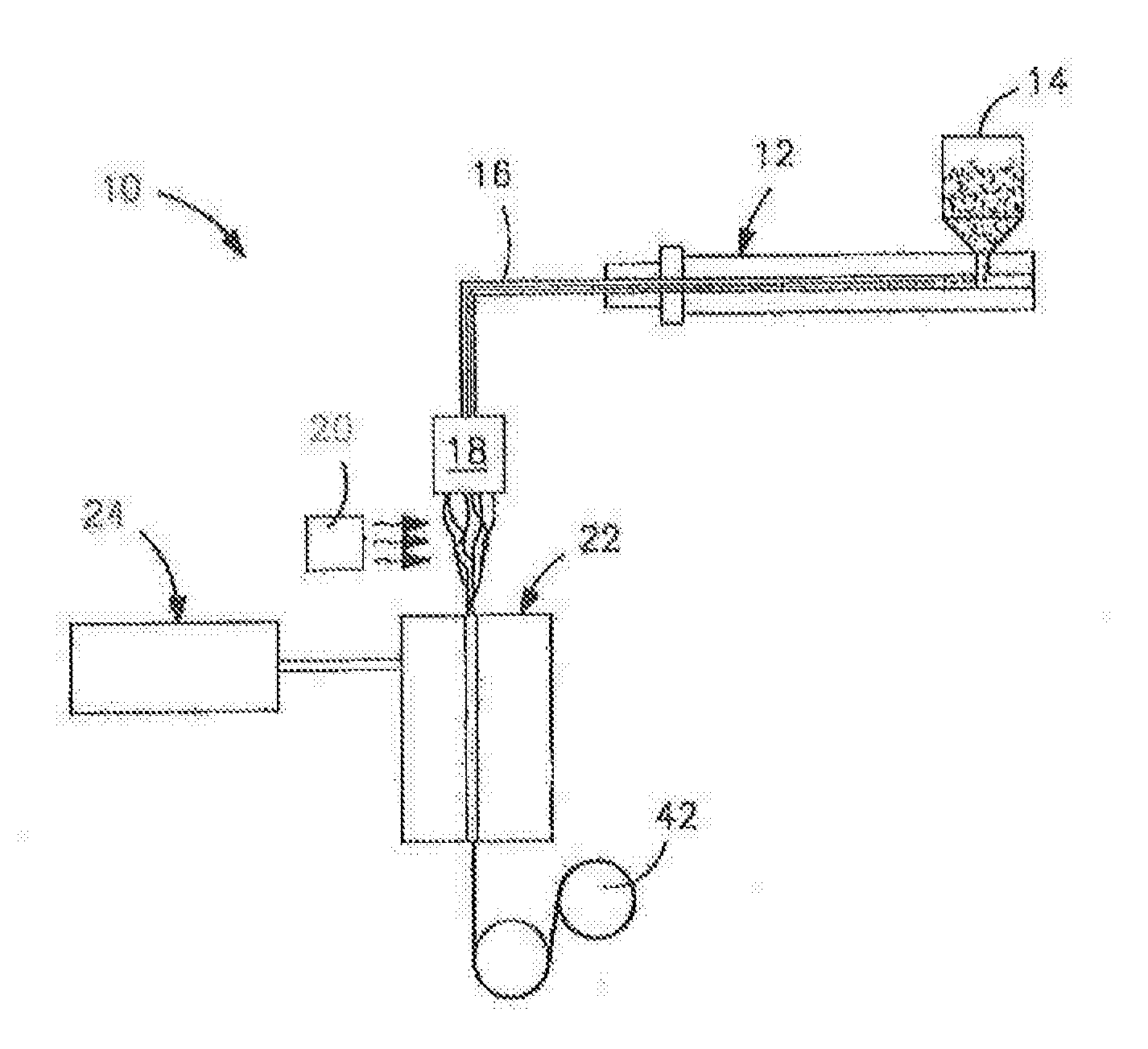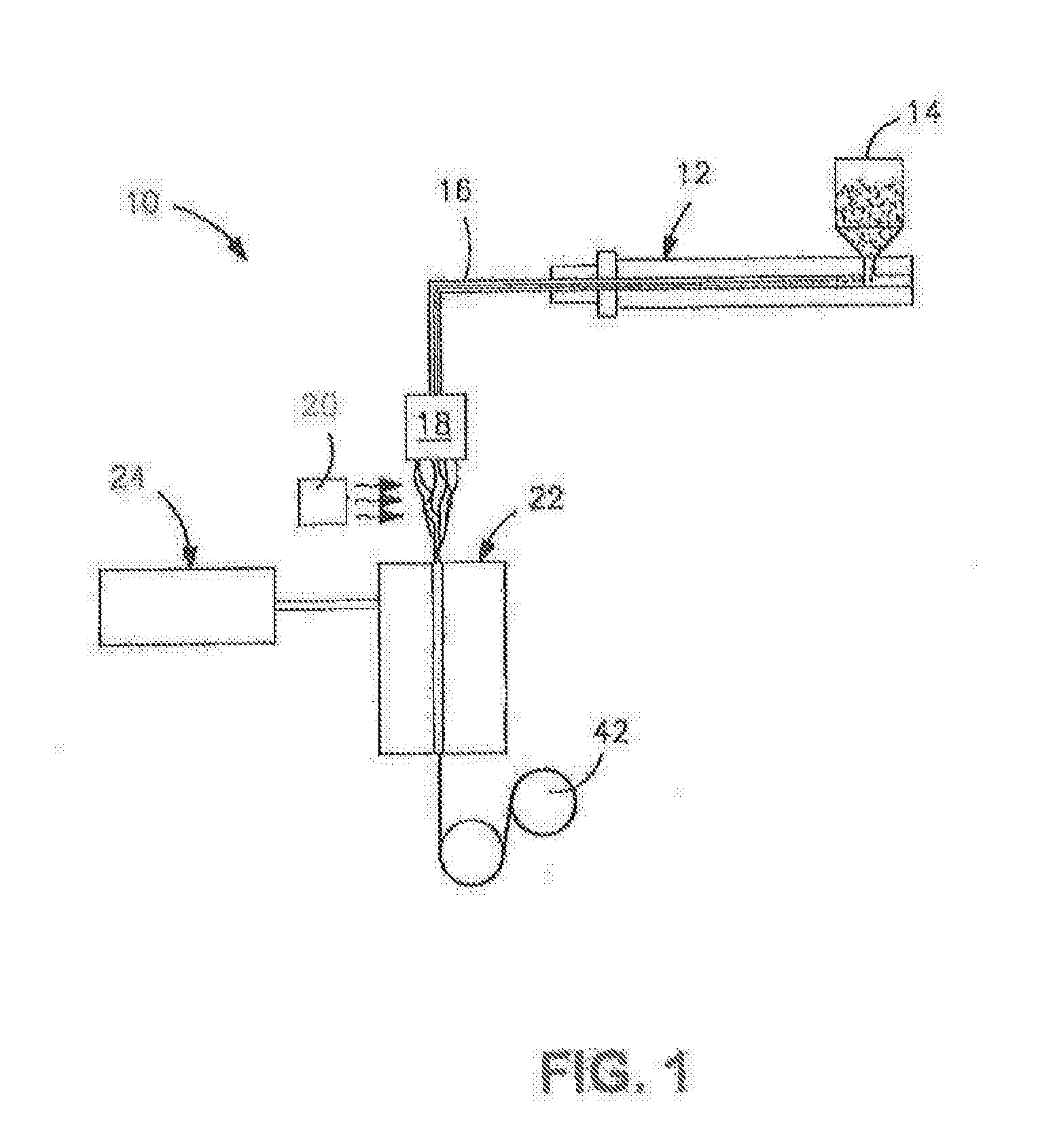Porous Polyolefin Fibers
a polyolefin fiber and porous technology, applied in the field of porous polyolefin fibers, can solve the problems of reducing the melt strength, breaking fibers, and low mechanical strength of products,
- Summary
- Abstract
- Description
- Claims
- Application Information
AI Technical Summary
Benefits of technology
Problems solved by technology
Method used
Image
Examples
example 1
[0136]A precursor blend was formed from 91.8 wt. % isotactic propylene homopolymer (M3661, melt flow rate of 14 g / 10 at 230° C. and melting temperature of 150° C., Total Petrochemicals), 7.4 wt. % polylactic acid (PLA 6252, melt flow rate of 70 to 85 g / 10 min at 210° C., Natureworks®), and 0.7 wt. % of a polyepoxide. The polyepoxide was poly(ethylene-co-methyl acrylate-co-glycidyl methacrylate) (LOTADER® AX8900, Arkema) having a melt flow rate of 6 g / 10 min (190° C. / 2160 g), a glycidyl methacrylate content of 8 wt. %, ethyl acrylate content of 24 wt. %, and ethylene content of 68 wt. %. The components were compounded in a co-rotating twin-screw extruder (Werner and Pfleiderer ZSK-30 with a diameter of 30 mm and a L / D=44). The extruder had seven heating zones. The temperature in the extruder ranged from 180° C. to 220° C. The polymer was fed gravimetrically to the extruder at the hoper at 15 pounds per hour and the liquid was injected into the barrel using a peristaltic pump. The ext...
example 2
[0138]A blend of 93 wt. % polypropylene (Total M3661) and 7 wt. % Lotader® AX8900) were compounded in a co-rotating twin-screw extruder (Werne and Pfleiderer ZSK-30 with a diameter of 30 mm and a L / D=44). The extruder had seven heating zones. The temperature in the extruder ranged from 180° C. to 220° C. The polymer was feed gravimetrically to the extruder at the hoper at 15 pounds per hour. The extruder was operated at 200 revolutions per minute (RPM). In the last section of the barrel (front), a 3-hole die of 6 mm in diameter was used to form the extrudate. The extrudate was air-cooled in a conveyor belt and pelletized using a Conair Pelletizer. Fiber was then produced from the precursor blend using a Davis-Standard fiber spinning line equipped with a 0.75-inch single screw extruder and 16 hole spinneret with a diameter of 0.6 mm. The fibers were collected at different draw down ratios. The take up speed ranged from 1 to 1000 m / min. The temperature of the extruder ranged from 175°...
example 3
[0139]A blend of 91.1 wt. % polypropylene (Total M3661), 7.4 wt. % polylactic acid (NatureWorks 6251), and 1.5% Lotader® AX8900) were compounded in the extruder and the conditions described in Example 2. In this case, 5% of Pluriol® WI 285 was then injected to the barrel using a peristaltic pump. Fiber was then produced from the precursor blend using a Davis-Standard fiber spinning line equipped with a 0.75-inch single screw extruder and 16 hole spinneret with a diameter of 0.6 mm. The fibers were collected at different draw down ratios. The take up speed ranged from 1 to 1000 m / min. The temperature of the extruder ranged from 175° C. to 220° C. The fibers were stretched in a tensile tester machine at 300 mm / min up to 400% elongation at 25° C. To analyze the material morphology, the fibers were freeze fractured in liquid nitrogen and analyzed via Scanning Electron Microscope Jeol 6490LV at high vacuum. The results are shown in FIG. 7-8.
PUM
| Property | Measurement | Unit |
|---|---|---|
| melting temperature | aaaaa | aaaaa |
| glass transition temperature | aaaaa | aaaaa |
| temperature | aaaaa | aaaaa |
Abstract
Description
Claims
Application Information
 Login to View More
Login to View More - Generate Ideas
- Intellectual Property
- Life Sciences
- Materials
- Tech Scout
- Unparalleled Data Quality
- Higher Quality Content
- 60% Fewer Hallucinations
Browse by: Latest US Patents, China's latest patents, Technical Efficacy Thesaurus, Application Domain, Technology Topic, Popular Technical Reports.
© 2025 PatSnap. All rights reserved.Legal|Privacy policy|Modern Slavery Act Transparency Statement|Sitemap|About US| Contact US: help@patsnap.com



